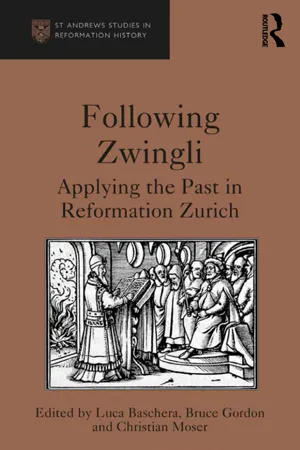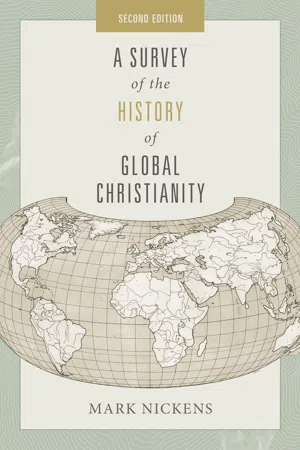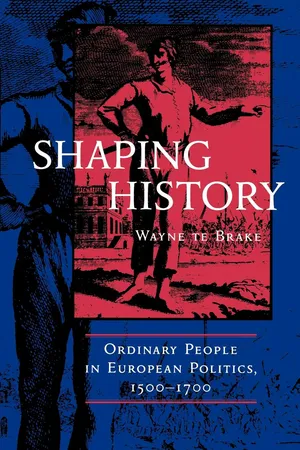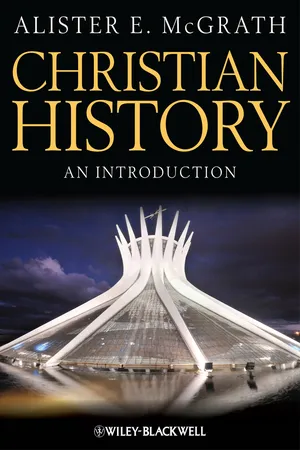History
Swiss Reformation
The Swiss Reformation was a religious movement in Switzerland during the 16th century, led by figures such as Huldrych Zwingli and John Calvin. It resulted in the establishment of Protestantism as an alternative to Roman Catholicism in several Swiss cantons. The movement emphasized the authority of the Bible and the priesthood of all believers, leading to significant changes in religious and social structures.
Written by Perlego with AI-assistance
Related key terms
Related key terms
1 of 4
Related key terms
1 of 3
6 Key excerpts on "Swiss Reformation"
- eBook - ePub
Following Zwingli
Applying the Past in Reformation Zurich
- Luca Baschera, Bruce Gordon(Authors)
- 2016(Publication Date)
- Routledge(Publisher)
The reformation in Zurich, as in all German and Swiss cities where reform movements gained purchase, drew together theology, politics, personalities and local conditions with the unanticipated. Countervailing forces, internal and external, created a torrid atmosphere, a volatile community in which Zwingli delivered his thunderous sermons from the city’s main pulpit. It is not difficult to imagine how the events of the 1520s could have taken a different turn had circumstances changed even slightly, so precarious was the situation. Zurich’s theology and church institutions were forged in the fires of battle, polemical and, ultimately, military. In a mere six years between 1525 and 1531 the city was convulsed by a change of church, a peasants’ revolt, the rise of radicalism and subsequent executions of its adherents, doctrinal controversy with Luther and the evaporation of any hope of Protestant unity, civil war in the Confederation and a humiliating defeat at Kappel in which Zwingli was killed and his body ritually desecrated. This was not cowbells and Heidi, but a bloodstained religious revolution in which theology and historical identity were the very things for which each side was prepared to put the other to death.The chapters in this volume explore how Zurich emerged as a distinctive centre of the European reformation with a carefully hewn theology and ecclesiology. The focus of the book is confined to the principal reformers of the first two generations of the reformation and for the most part our project treats the theological, historical and pedagogical thought of the leading figures. Our central question is how a radically new form of Christian community was created in the sixteenth century and how various types of models were employed to form patterns of learning, piety and behaviour. Such transformative authority was not simply identity construction through the appropriation of the past, although that is certainly relevant to the discussion. Our purpose is to examine how the leaders of the Reformation in Zurich looked to the past to makes sense of their present and to give shape to a reformed Christian community. A community, they believed, that even in its imperfections was eschatological. The heavenly kingdom could in part be realized, awaiting its fulfillment at the end of time. The chapters take the view that it is insufficient to consider convictions, theological and historical arguments and attempts at their implementation merely in terms of justification for decisions already made, although none can be entirely exonerated of a degree of opportunism and elastic readings of history. In examining the envisaged community formation, with its selective reading of intellectual, biblical and historical sources, as well as in its accommodation to political and social realities, we take very seriously the beliefs of the protagonists. - Mark Nickens(Author)
- 2020(Publication Date)
- B&H Academic(Publisher)
Chapter 6 The Swiss ReformationWhile Luther and his movement matured in Germany, other reform movements began and grew in the land just south of Germany: Switzerland, with Ulrich Zwingli, the Anabaptists, and John Calvin. These three movements developed different doctrines, practices, and leadership structures from Luther and each other. They all emerged within the sixteenth century and had different lasting impacts. Zwingli’s legacy lasted through the influence of his writings and ideas; no centralized movement or later denomination developed from his teachings like the Lutherans developed from Luther’s teachings and leadership. The Anabaptists were not birthed as one group but formed independently in different locations throughout northern Europe, usually with no knowledge of the other groups, although the main group formed in Switzerland. These separate groups shared common ideas, such as believer’s baptism. Therefore, they are lumped together in the movement known as “Anabaptism,” although they never united or even met collectively in a conference or gathering. Calvin’s ideas did inspire movements and even influence the creation of churches and denominations. Yet the common attribute for all three was their development in the unique political structure that was Switzerland.Outline- The Canton System in Switzerland
- Ulrich Zwingli (1484–1531)
- The Anabaptists
- John Calvin (1509–1564)
- The Varied Influences of Leadership Structures on Reformation Churches
A basic knowledge of the Swiss canton system is indispensable in understanding how the different Swiss reform movements developed. Germany had long used a feudal system, resulting in the reign of princes who controlled different small regions. Switzerland did not have nobility and instead relied on a system of “cantons” or small states, each with a central city and a city council responsible for the surrounding region. In the sixteenth century, the Swiss Confederacy consists of thirteen cantons. The cantons were loosely linked, but not in the same fashion as states in a modern nation. For example, they did not have a prime minister or president responsible for all the cantons. Instead, they were held together by a shared sense of common heritage and overall purpose.- eBook - ePub
Shaping History
Ordinary People in European Politics, 1500-1700
- Wayne te Brake(Author)
- 2023(Publication Date)
- University of California Press(Publisher)
Figure 5 illustrates these complex and variant experiences and accounts for them in terms of the interactions between variously resistant local rulers and variously constituted reformation coalitions. Although many German and Swiss cities followed a fairly simple trajectory from confrontation to compromise, this was by no means a simple or universal experience. But in the final analysis, what is striking about all of these urban reformations is that they involved a political process— that is, an interaction between subjects and rulers—in which the local officials of the established Church often played relatively minor roles. Of course, the Roman Catholic church itself was weakened and divided by the defection of prelates and priests, especially in the early years of the Reformation, but more generally it is true that the terrain of cultural/religious authority was quite effectively contested by evangelical preachers.AUTOMany communities arranged debates or disputations between Catholics and evangelicals as part of the political process leading toward the adoption of reform; that the result was in many cases a foregone conclusion did nothing to enhance the Church’s ability to speak authoritatively on matters of faith. Not surprisingly, the Catholic church was most successful in fending off the reformation process in those urban political spaces where it claimed both temporal and ecclesiastical authority. But even in ecclesiastical states, the Church was vulnerable because the prince-bishops were so frequently absentees who ruled only indirectly. Thus in the episcopal city of Geneva, on the southwestern frontier of the empire, for example, the prelude to religious reform was political revolution against the bishop’s temporal authority in the 1520s (Monter 1967; Kingdon 1974). Figure 5 - eBook - ePub
God Hovered Over the Waters
The Emergence of the Protestant Reformation
- dePrater(Author)
- 2015(Publication Date)
- Wipf and Stock(Publisher)
4The Reformation in Switzerland
Huldrych Zwingli The Early YearsC hief among the German- speaking Swiss reformers was Huldrych (or Ulrich) Zwingli. Zwingli was born to Ulrich and Margaretha Zwingli in 1484 , on a farm in the small eastern Swiss village of Wildhaus. His father was the village bailiff and a shepherd, and therefore Zwingli grew up under comfortable circumstances. While tending sheep with his father on the beautiful steep slopes of the Alps, Zwingli developed a love for his country that he would express through his deep sense of patriotism. An uncle, the dean of Wiesen, saw that Zwingli had the opportunity to receive the finest humanist education. Zwingli therefore studied for two years at the University of Vienna, followed by studies at the University of Basel at which, in 1506 , he was awarded a master’s degree. Following his academic theological studies, he was ordained as the parish priest of his boyhood church, the Glarus parish in Zurich. Zwingli was well suited for his congregation, and he took his priestly duties very seriously.Zwingli’s Pastoral MinistryOver the years, foreign rulers had come to recognize the Swiss military as among the best in the world. They therefore sought after their service as mercenary troops. In 1513 , as a reward for his affirmation of Swiss troops serving as mercenaries in support of the pope’s military campaigns, the pope granted Zwingli financial aid. As their field chaplain, in 1512 and 1515 , Zwingli accompanied the young men in his parish during several papal military campaigns. The French king likewise sought to employ Swiss mercenary troops for his own military ventures. Yet Zwingli spoke out against using Swiss troops in the service of other nations. In retaliation for Zwingli’s outspokenness, French government supporters stirred up discontent within Zwingli’s Glarus parish. Recognizing the extent of the discontent, he also assumed preaching duties at the historic shrine at Einsiedeln. In 1516 - eBook - ePub
Christian History
An Introduction
- Alister E. McGrath(Author)
- 2012(Publication Date)
- Wiley-Blackwell(Publisher)
Weber saw this fundamental change in attitude particularly well illustrated by a number of seventeenth-century Calvinist writers such as the American politician and writer Benjamin Franklin (1706–90), whose writings affirmed the accumulation of capital through engagement with the world, while criticizing its consumption. Capital was to be seen as something that was to be increased, not something that was to be consumed. While Weber’s thesis remains contested, there is little doubt that one of the most interesting features of Protestantism is its impact on the world of work and money.Thus far, we have considered some general features of the thought and practice of Protestantism which were shared across the movement. In what follows, we shall consider each element of Protestantism in more detail, before moving on to consider the Catholic reformation. We begin by reflecting on the development and ideas of the mainline reformation in Germany and Switzerland.3.3. The Mainstream Reformation: Luther, Zwingli, and Calvin
History is shaped by a combination of forces – social, economic, political, and religious. All of these factors helped to shape the development of the upheavals of the sixteenth century. However, it is widely agreed that three individual thinkers played a significant role in shaping and directing this movement: Martin Luther (1483–1546), Huldrych Zwingli (1484–1531), and John Calvin (1509–64). In what follows, we shall consider these three figures, and their impact on Christian history during the sixteenth century.All three of these thinkers belong to the mainstream reforming movement that is often referred to as the “magisterial Reformation,” in which a close relationship was envisaged between the church and state, with the “magistracy” – in other words, the civil authorities, whether this takes the form of a monarchy or a city council – having a significant influence over the church, and the implementation of the Christian faith in their local region. As we shall see in a later section, more radical wings of the Reformation often rejected any such relationship.3.3.1. Martin Luther: A Brief History
Martin Luther was born on November 10, 1483, in the German town of Eisleben. Luther began his university education at Erfurt in 1501. He was ordained as a priest in 1507, and was awarded the degree of Doctor of Divinity in 1512. This allowed him to take up an academic teaching position at the newly founded University of Wittenberg. - eBook - ePub
The Reformation
A Brief History
- Kenneth G. Appold(Author)
- 2011(Publication Date)
- Wiley-Blackwell(Publisher)
At least some urban authorities also reacted negatively to the Reformation’s ideas. The urban reform movements were about more than power and politics. They were also motivated by missional impulses, a quest for more authentic holiness in a new social and cultural context. Not surprisingly, there were different opinions on how to achieve that. For Zwingli, it had to do with paring the Christian religion down to its essentials, carving away “human traditions” and other externals in order to emphasize an inner, spiritual core of faith. Even among reform-minded Christians, there was genuine disagreement over the value of externals, however. Zurich’s Konrad Hoffmann was not alone (and not just reactionary) in objecting to changes in eucharistic practice. Some—including even Luther—felt that fasting, understood properly, could be a useful spiritual exercise. There were also many who sincerely believed that marriage was incompatible with a clerical ethos. Others found iconoclasm repellent and saw the visual arts as an important educational tool. And, of course, there were some who simply took sober stock of the Reformers’ theology—and remained unconvinced.Still, the great majority of imperial cities did come to embrace the Reformation and bore considerable responsibility for its eventual success. The story of the countryside, on the other hand, was quite different.Rural Revolution of the ‘Common Man’The vast majority of Europe’s inhabitants did not live in cities; Europe was mostly rural. For these people, the Reformation was a more ambiguous event, as much a source of disappointment as it was of hope. These are the people who figure most sparingly in traditional accounts of Reformation history—but theirs are the stories by which the Reformation’s success and legacy needs also to be assessed.Most of Europe’s rural people were peasants. Many of these lived in some form of feudal servitude. By most indications, the quality of their lives had taken a marked turn for the worse in the fifteenth and early sixteenth centuries. Almost all peasants remain nameless to history; they could not write their own life-stories, nor were their individual lives so exceptional as to warrant documentation by those who could write. But exceptions did occur. During the fifteenth century, Europe’s peasants began to complain. And at least some of those complaints found their way into writing and were submitted to authorities. Still nameless for the most part, the peasants now, at least, left a record. Someone took notice; the nameless were finding a voice.
Index pages curate the most relevant extracts from our library of academic textbooks. They’ve been created using an in-house natural language model (NLM), each adding context and meaning to key research topics.
Explore more topic indexes
Explore more topic indexes
1 of 6
Explore more topic indexes
1 of 4





